belt Hyundai H-100 Truck 2010 Owner's Manuals
[x] Cancel search | Manufacturer: HYUNDAI, Model Year: 2010, Model line: H-100 Truck, Model: Hyundai H-100 Truck 2010Pages: 207, PDF Size: 7.9 MB
Page 2 of 207
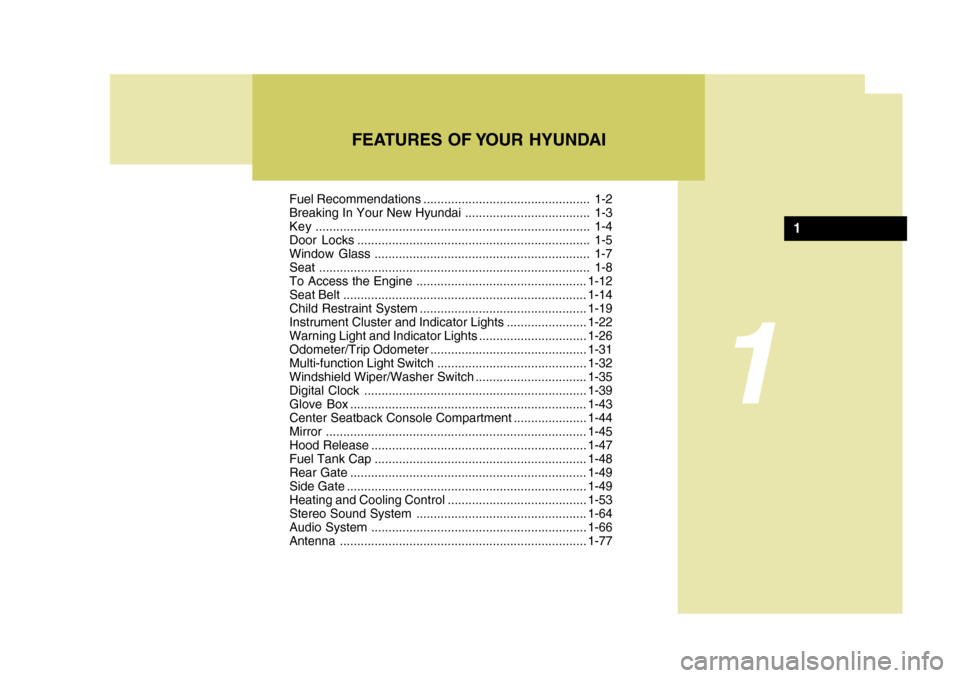
Fuel Recommendations ................................................ 1-2
Breaking In Your New Hyundai .................................... 1-3
Key ............................................................................... 1-4
Door Locks ................................................................... 1-5
Window Glass .............................................................. 1-7
Seat ..............................................................................1-8
To Access the Engine ................................................. 1-12
Seat Belt ...................................................................... 1-14
Child Restraint System ................................................ 1-19
Instrument Cluster and Indicator Lights .......................1-22
Warning Light and Indicator Lights ...............................1-26
Odometer/Trip O dometer............................................. 1-31
Multi-function Light Switch ........................................... 1-32
Windshield Wiper/Washer Switch ................................1-35
Digital Clock ................................................................ 1-39
Glove Box .................................................................... 1-43
Center Seatback Console Compart ment .....................1-44
Mirror ........................................................................... 1-45
Hood R elease .............................................................. 1-47
Fuel Tank Ca p ............................................................. 1-48
Rear Gat e .................................................................... 1-49
Side Gate ..................................................................... 1-49
Heating and Cooling Control .......... ..............................1-53
Stereo Sound System ................................................. 1-64
Audio System .............................................................. 1-66
Antenna ....................................................................... 1-77
FEATURES OF YOUR HYUNDAI
1
1
Page 6 of 207
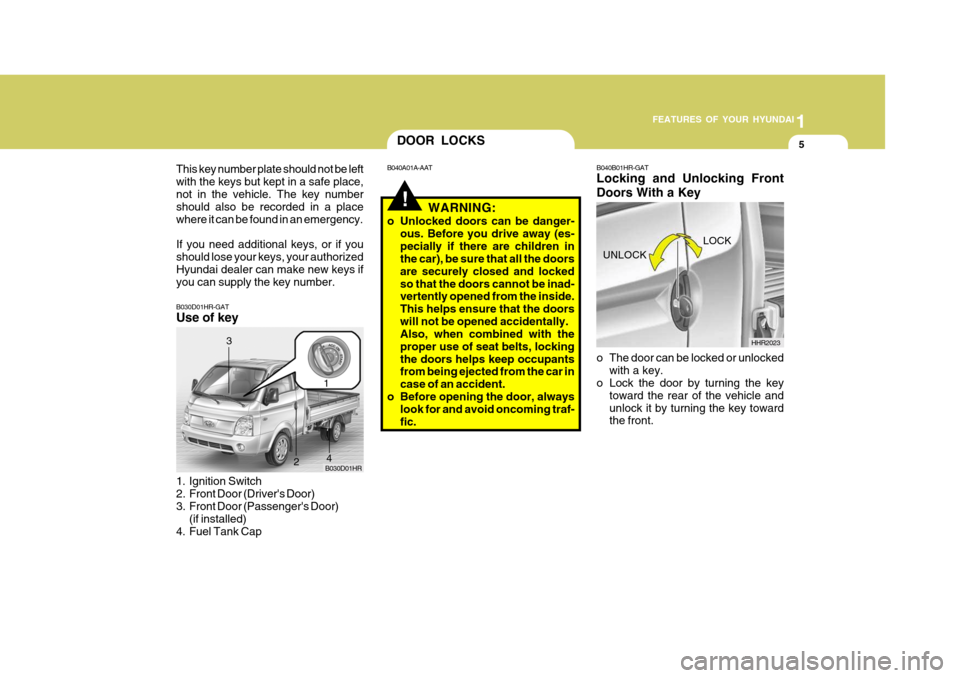
1
FEATURES OF YOUR HYUNDAI
5
B030D01HR-GAT Use of key
1. Ignition Switch
2. Front Door (Driver's Door)
3. Front Door (Passenger's Door)
(if installed)
4. Fuel Tank Cap B030D01HR
1
2
3
4
!
DOOR LOCKS
B040A01A-AAT
WARNING:
o Unlocked doors can be danger- ous. Before you drive away (es- pecially if there are children in the car), be sure that all the doors are securely closed and lockedso that the doors cannot be inad- vertently opened from the inside. This helps ensure that the doorswill not be opened accidentally. Also, when combined with the proper use of seat belts, lockingthe doors helps keep occupants from being ejected from the car in case of an accident.
o Before opening the door, always look for and avoid oncoming traf-fic.
UNLOCK
HHR2023
LOCK
B040B01HR-GAT Locking and Unlocking Front Doors With a Key
o The door can be locked or unlocked
with a key.
o Lock the door by turning the key
toward the rear of the vehicle and unlock it by turning the key toward the front.
This key number plate should not be left with the keys but kept in a safe place,not in the vehicle. The key number should also be recorded in a place where it can be found in an emergency. If you need additional keys, or if you should lose your keys, your authorizedHyundai dealer can make new keys if you can supply the key number.
Page 10 of 207
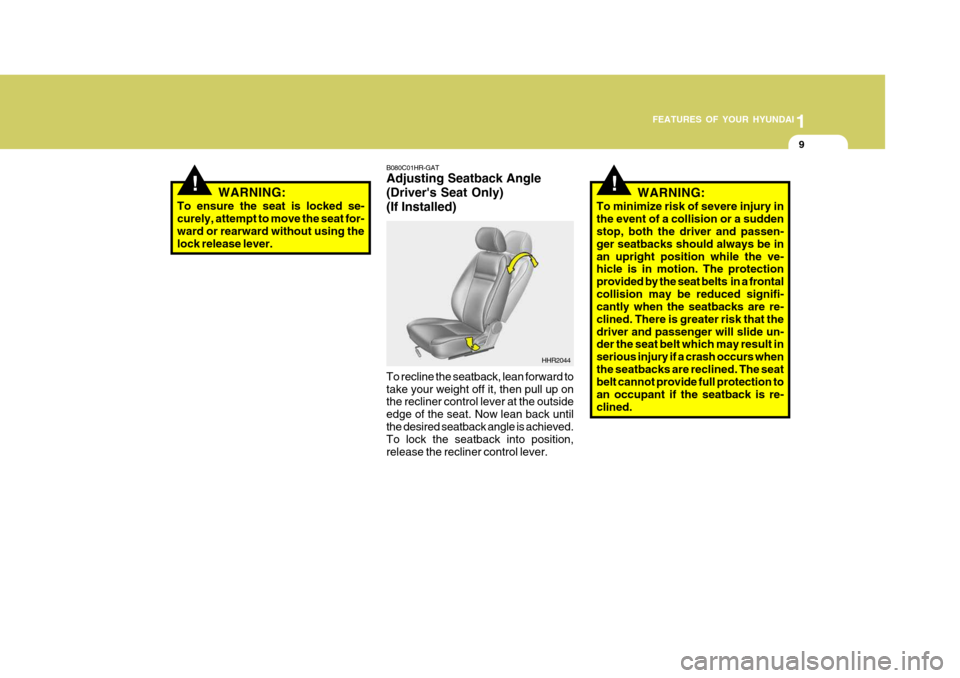
1
FEATURES OF YOUR HYUNDAI
9
!
B080C01HR-GAT Adjusting Seatback Angle (Driver's Seat Only)(If Installed)
HHR2044
WARNING:
To ensure the seat is locked se- curely, attempt to move the seat for- ward or rearward without using thelock release lever.
!WARNING:
To minimize risk of severe injury in the event of a collision or a sudden stop, both the driver and passen- ger seatbacks should always be inan upright position while the ve- hicle is in motion. The protection provided by the seat belts in a frontalcollision may be reduced signifi- cantly when the seatbacks are re- clined. There is greater risk that thedriver and passenger will slide un- der the seat belt which may result in serious injury if a crash occurs whenthe seatbacks are reclined. The seat belt cannot provide full protection to an occupant if the seatback is re-clined.
To recline the seatback, lean forward totake your weight off it, then pull up on the recliner control lever at the outside edge of the seat. Now lean back untilthe desired seatback angle is achieved. To lock the seatback into position, release the recliner control lever.
Page 12 of 207
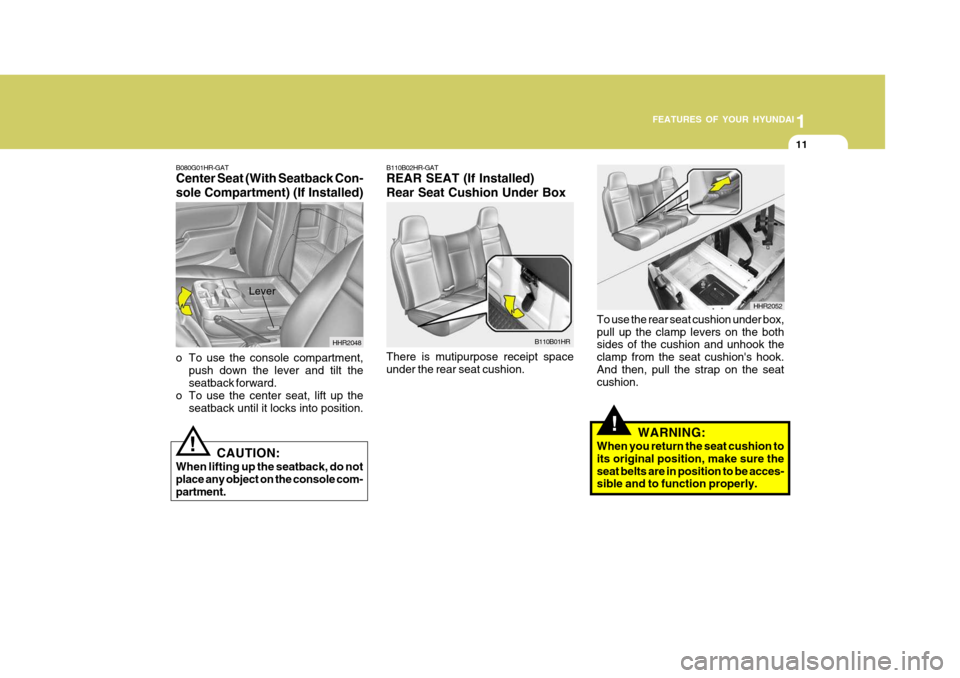
1
FEATURES OF YOUR HYUNDAI
11
B080G01HR-GAT Center Seat (With Seatback Con- sole Compartment) (If Installed)
HHR2048
o To use the console compartment, push down the lever and tilt the seatback forward.
o To use the center seat, lift up the seatback until it locks into position.
CAUTION:
When lifting up the seatback, do not place any object on the console com-partment.
!
Lever
B110B02HR-GAT REAR SEAT (If Installed) Rear Seat Cushion Under Box There is mutipurpose receipt space under the rear seat cushion. B110B01HR
HHR2052
!
To use the rear seat cushion under box, pull up the clamp levers on the both sides of the cushion and unhook the clamp from the seat cushion's hook.And then, pull the strap on the seat cushion.
WARNING:
When you return the seat cushion to its original position, make sure theseat belts are in position to be acces- sible and to function properly.
Page 15 of 207
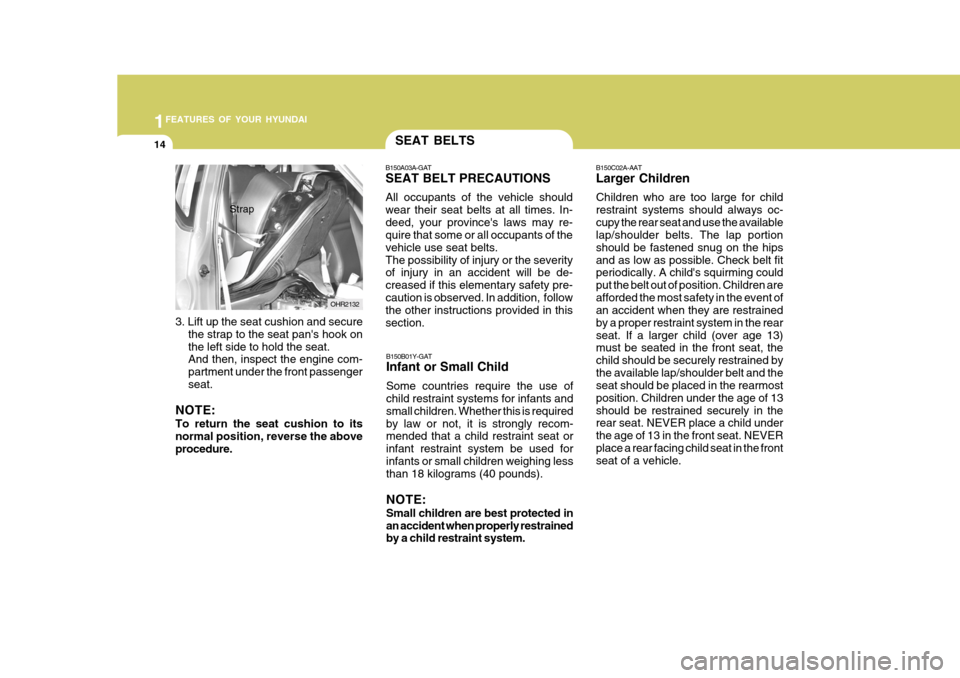
1FEATURES OF YOUR HYUNDAI
14
B150C02A-AAT Larger Children Children who are too large for child restraint systems should always oc-cupy the rear seat and use the available lap/shoulder belts. The lap portion should be fastened snug on the hipsand as low as possible. Check belt fit periodically. A child's squirming could put the belt out of position. Children areafforded the most safety in the event of an accident when they are restrained by a proper restraint system in the rearseat. If a larger child (over age 13) must be seated in the front seat, the child should be securely restrained bythe available lap/shoulder belt and the seat should be placed in the rearmost position. Children under the age of 13should be restrained securely in the rear seat. NEVER place a child under the age of 13 in the front seat. NEVERplace a rear facing child seat in the front seat of a vehicle.SEAT BELTS
B150A03A-GAT SEAT BELT PRECAUTIONS All occupants of the vehicle should wear their seat belts at all times. In-deed, your province's laws may re- quire that some or all occupants of the vehicle use seat belts.The possibility of injury or the severity of injury in an accident will be de- creased if this elementary safety pre-caution is observed. In addition, follow the other instructions provided in this section.
B150B01Y-GAT Infant or Small Child Some countries require the use of child restraint systems for infants and small children. Whether this is requiredby law or not, it is strongly recom- mended that a child restraint seat or infant restraint system be used forinfants or small children weighing less than 18 kilograms (40 pounds). NOTE: Small children are best protected in an accident when properly restrained by a child restraint system.
OHR2132
3. Lift up the seat cushion and secure the strap to the seat pan's hook on the left side to hold the seat. And then, inspect the engine com- partment under the front passengerseat.
NOTE: To return the seat cushion to its normal position, reverse the aboveprocedure.
Strap
Page 16 of 207
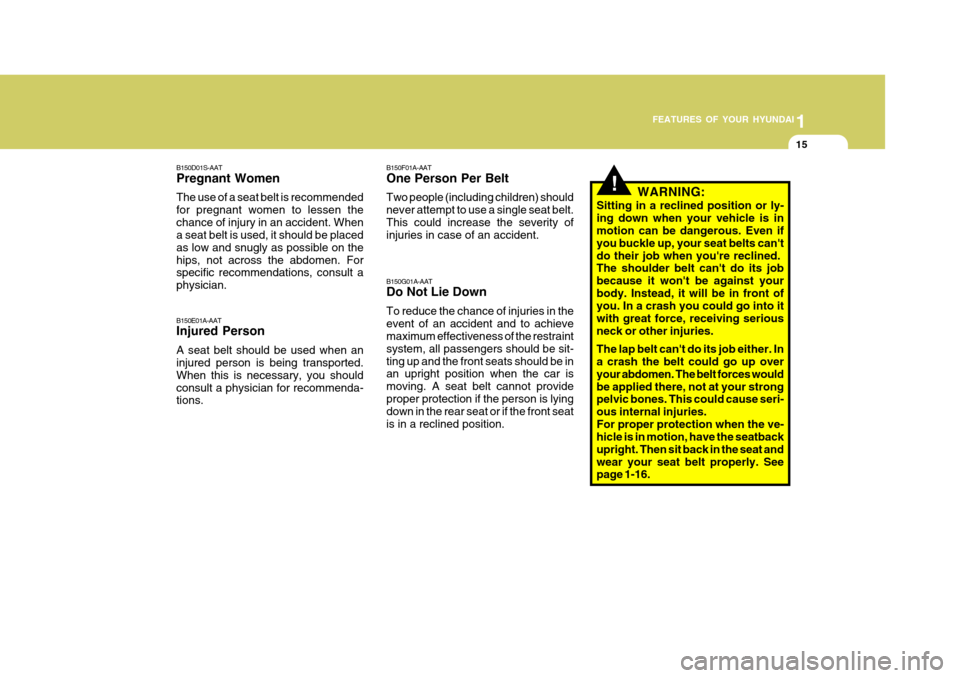
1
FEATURES OF YOUR HYUNDAI
15
B150D01S-AAT Pregnant Women The use of a seat belt is recommended for pregnant women to lessen thechance of injury in an accident. When a seat belt is used, it should be placed as low and snugly as possible on thehips, not across the abdomen. For specific recommendations, consult a physician. B150E01A-AAT Injured Person A seat belt should be used when an injured person is being transported. When this is necessary, you shouldconsult a physician for recommenda- tions. B150G01A-AAT Do Not Lie Down To reduce the chance of injuries in the event of an accident and to achieve maximum effectiveness of the restraint system, all passengers should be sit-ting up and the front seats should be in an upright position when the car is moving. A seat belt cannot provideproper protection if the person is lying down in the rear seat or if the front seat is in a reclined position.
B150F01A-AAT One Person Per Belt Two people (including children) should never attempt to use a single seat belt.This could increase the severity of injuries in case of an accident.
!WARNING:
Sitting in a reclined position or ly- ing down when your vehicle is in motion can be dangerous. Even if you buckle up, your seat belts can'tdo their job when you're reclined. The shoulder belt can't do its job because it won't be against yourbody. Instead, it will be in front of you. In a crash you could go into it with great force, receiving seriousneck or other injuries. The lap belt can't do its job either. In a crash the belt could go up over your abdomen. The belt forces wouldbe applied there, not at your strong pelvic bones. This could cause seri- ous internal injuries.For proper protection when the ve- hicle is in motion, have the seatback upright. Then sit back in the seat andwear your seat belt properly. See page 1-16.
Page 17 of 207
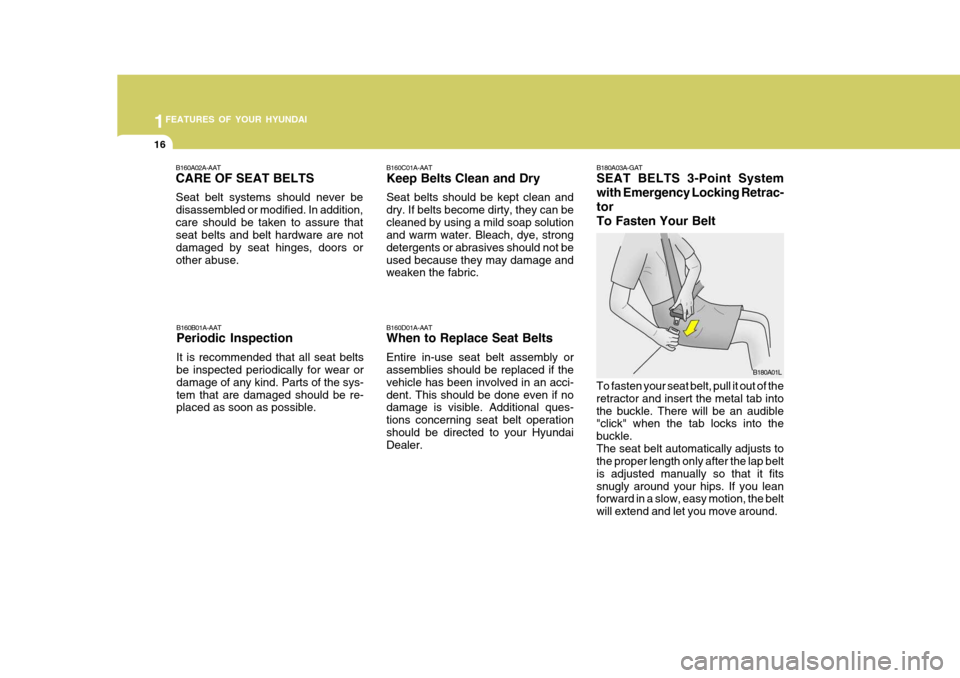
1FEATURES OF YOUR HYUNDAI
16
B180A03A-GAT SEAT BELTS 3-Point System with Emergency Locking Retrac-torTo Fasten Your Belt
To fasten your seat belt, pull it out of the retractor and insert the metal tab intothe buckle. There will be an audible "click" when the tab locks into the buckle.The seat belt automatically adjusts to the proper length only after the lap belt is adjusted manually so that it fitssnugly around your hips. If you lean forward in a slow, easy motion, the belt will extend and let you move around. B180A01L
B160D01A-AAT When to Replace Seat Belts Entire in-use seat belt assembly or assemblies should be replaced if the vehicle has been involved in an acci-dent. This should be done even if no damage is visible. Additional ques- tions concerning seat belt operationshould be directed to your Hyundai Dealer.
B160B01A-AAT Periodic Inspection It is recommended that all seat belts be inspected periodically for wear or damage of any kind. Parts of the sys-tem that are damaged should be re- placed as soon as possible. B160C01A-AAT Keep Belts Clean and Dry Seat belts should be kept clean and dry. If belts become dirty, they can becleaned by using a mild soap solution and warm water. Bleach, dye, strong detergents or abrasives should not beused because they may damage and weaken the fabric.
B160A02A-AAT CARE OF SEAT BELTS Seat belt systems should never be disassembled or modified. In addition,care should be taken to assure that seat belts and belt hardware are not damaged by seat hinges, doors orother abuse.
Page 18 of 207
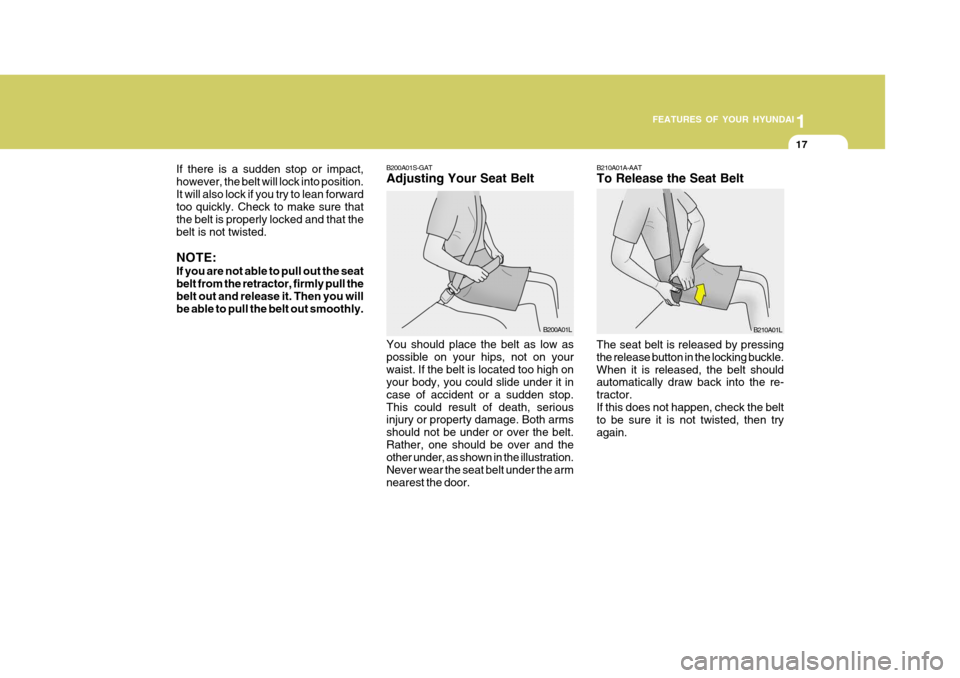
1
FEATURES OF YOUR HYUNDAI
17
If there is a sudden stop or impact, however, the belt will lock into position.It will also lock if you try to lean forward too quickly. Check to make sure that the belt is properly locked and that thebelt is not twisted. NOTE: If you are not able to pull out the seat belt from the retractor, firmly pull thebelt out and release it. Then you will be able to pull the belt out smoothly.
B200A01S-GAT Adjusting Your Seat Belt You should place the belt as low as possible on your hips, not on yourwaist. If the belt is located too high on your body, you could slide under it in case of accident or a sudden stop.This could result of death, serious injury or property damage. Both arms should not be under or over the belt.Rather, one should be over and the other under, as shown in the illustration. Never wear the seat belt under the armnearest the door. B200A01LB210A01A-AAT To Release the Seat Belt
The seat belt is released by pressing the release button in the locking buckle.When it is released, the belt should automatically draw back into the re- tractor.If this does not happen, check the belt to be sure it is not twisted, then try again. B210A01L
Page 19 of 207
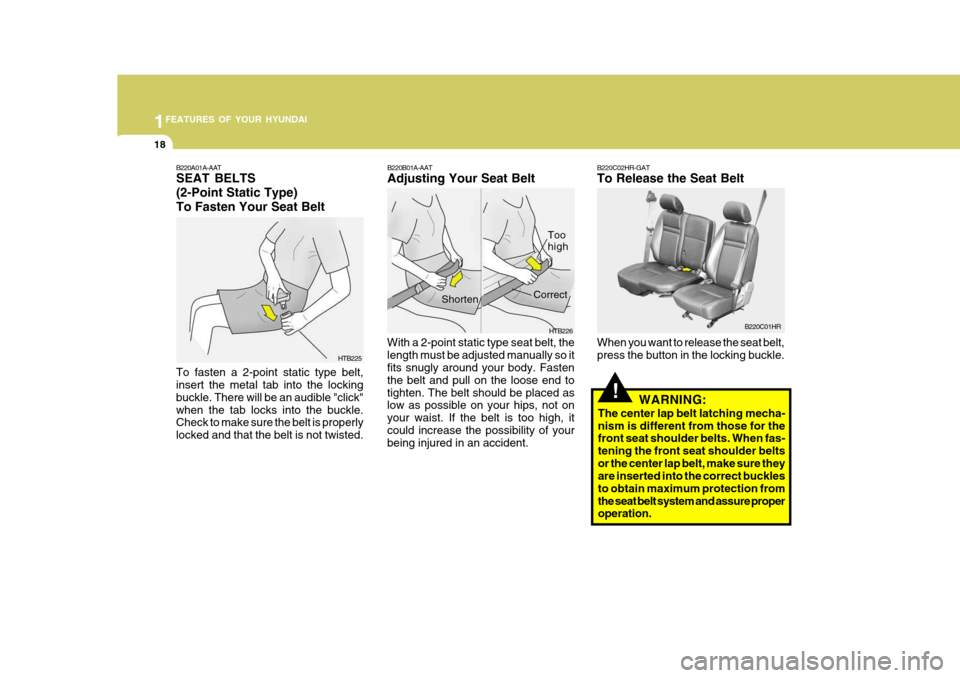
1FEATURES OF YOUR HYUNDAI
18
!
B220C02HR-GAT To Release the Seat Belt When you want to release the seat belt, press the button in the locking buckle. B220C01HR
WARNING:
The center lap belt latching mecha-nism is different from those for the front seat shoulder belts. When fas- tening the front seat shoulder beltsor the center lap belt, make sure they are inserted into the correct buckles to obtain maximum protection fromthe seat belt system and assure proper operation.B220B01A-AAT Adjusting Your Seat Belt
With a 2-point static type seat belt, the length must be adjusted manually so it fits snugly around your body. Fasten the belt and pull on the loose end totighten. The belt should be placed as low as possible on your hips, not on your waist. If the belt is too high, itcould increase the possibility of your being injured in an accident. HTB226
Correct
Shorten Too highB220A01A-AAT SEAT BELTS (2-Point Static Type)To Fasten Your Seat Belt
To fasten a 2-point static type belt, insert the metal tab into the locking buckle. There will be an audible "click"when the tab locks into the buckle. Check to make sure the belt is properly locked and that the belt is not twisted. HTB225
Page 20 of 207
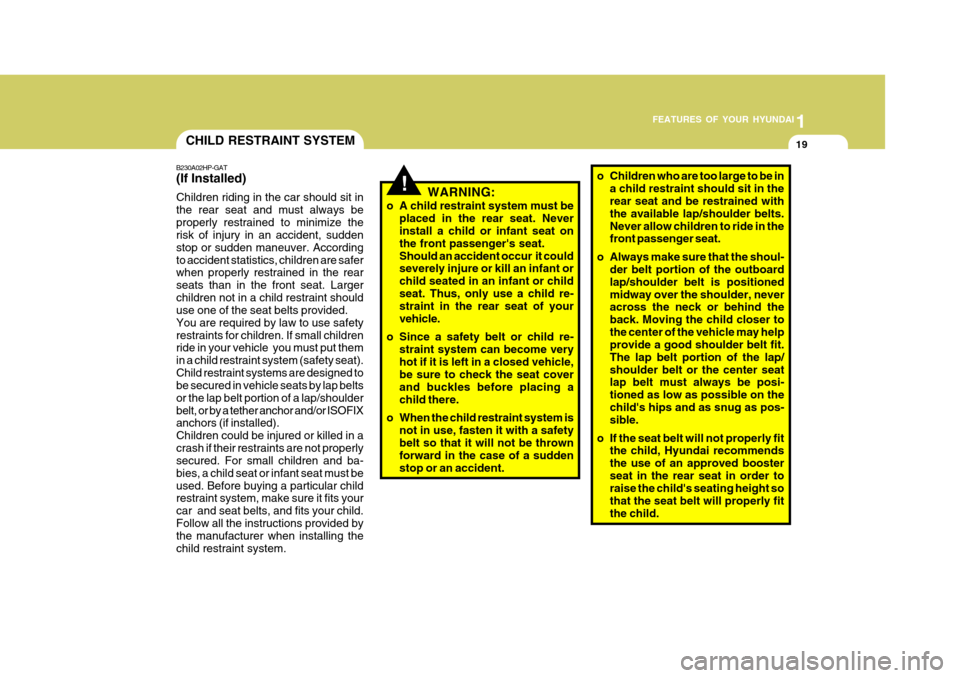
1
FEATURES OF YOUR HYUNDAI
19
WARNING:
o A child restraint system must be placed in the rear seat. Never install a child or infant seat on the front passenger's seat.Should an accident occur it could severely injure or kill an infant or child seated in an infant or childseat. Thus, only use a child re- straint in the rear seat of your vehicle.
o Since a safety belt or child re- straint system can become veryhot if it is left in a closed vehicle, be sure to check the seat cover and buckles before placing achild there.
o When the child restraint system is not in use, fasten it with a safety belt so that it will not be thrown forward in the case of a suddenstop or an accident.!
CHILD RESTRAINT SYSTEM
B230A02HP-GAT (If Installed) Children riding in the car should sit in the rear seat and must always beproperly restrained to minimize the risk of injury in an accident, sudden stop or sudden maneuver. Accordingto accident statistics, children are safer when properly restrained in the rear seats than in the front seat. Largerchildren not in a child restraint should use one of the seat belts provided. You are required by law to use safetyrestraints for children. If small children ride in your vehicle you must put them in a child restraint system (safety seat).Child restraint systems are designed to be secured in vehicle seats by lap belts or the lap belt portion of a lap/shoulderbelt, or by a tether anchor and/or ISOFIX anchors (if installed). Children could be injured or killed in acrash if their restraints are not properly secured. For small children and ba- bies, a child seat or infant seat must beused. Before buying a particular child restraint system, make sure it fits your car and seat belts, and fits your child.Follow all the instructions provided by the manufacturer when installing the child restraint system.
o Children who are too large to be in a child restraint should sit in the rear seat and be restrained with the available lap/shoulder belts.Never allow children to ride in the front passenger seat.
o Always make sure that the shoul- der belt portion of the outboard lap/shoulder belt is positionedmidway over the shoulder, never across the neck or behind the back. Moving the child closer tothe center of the vehicle may help provide a good shoulder belt fit. The lap belt portion of the lap/shoulder belt or the center seat lap belt must always be posi- tioned as low as possible on thechild's hips and as snug as pos- sible.
o If the seat belt will not properly fit the child, Hyundai recommends the use of an approved boosterseat in the rear seat in order to raise the child's seating height so that the seat belt will properly fitthe child.